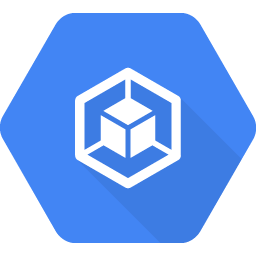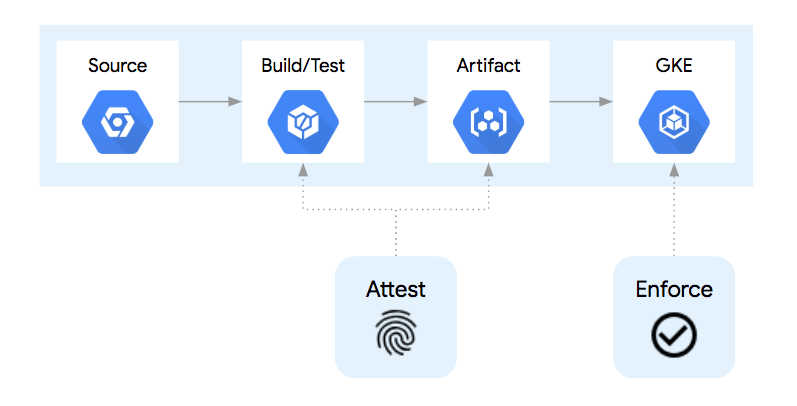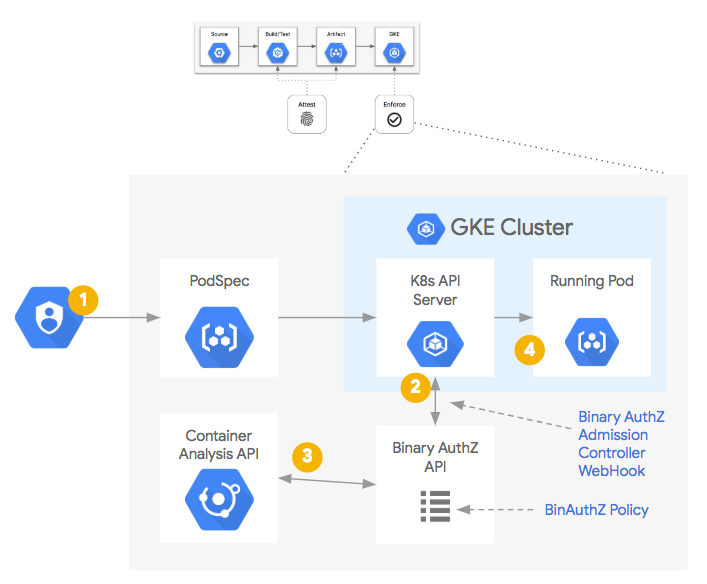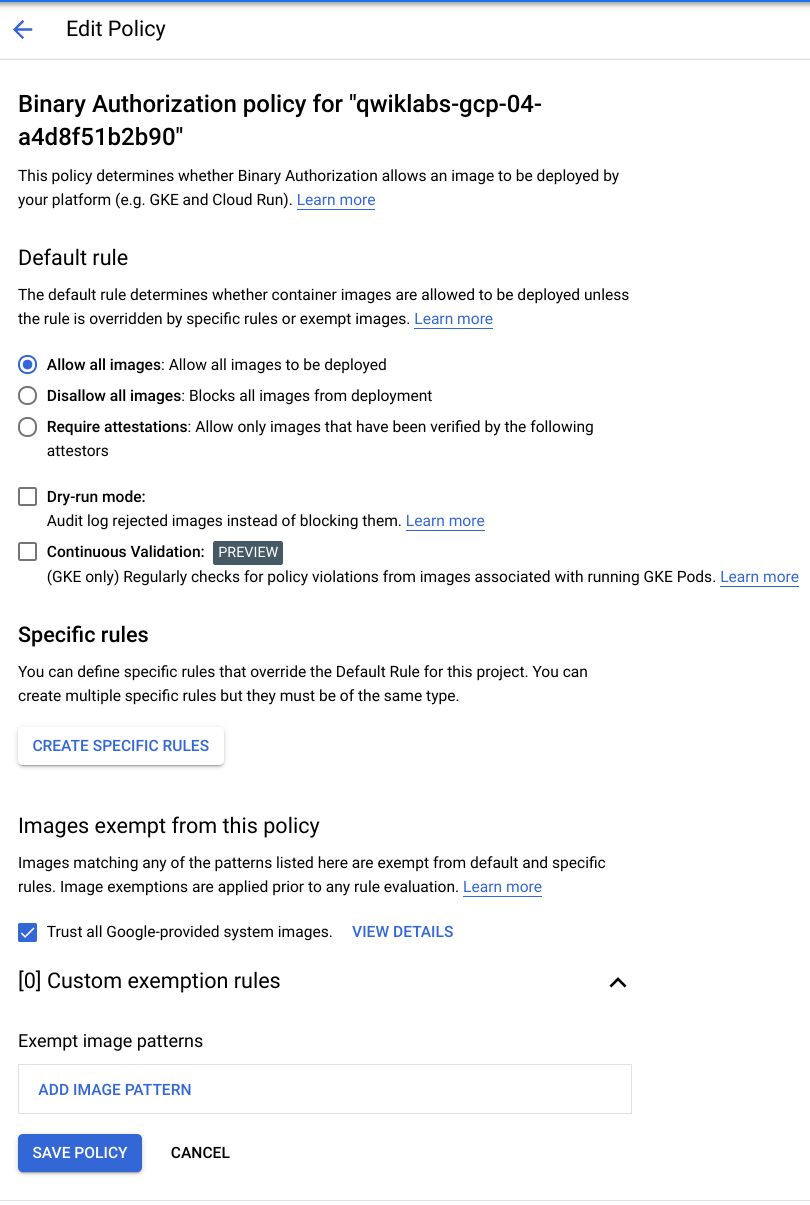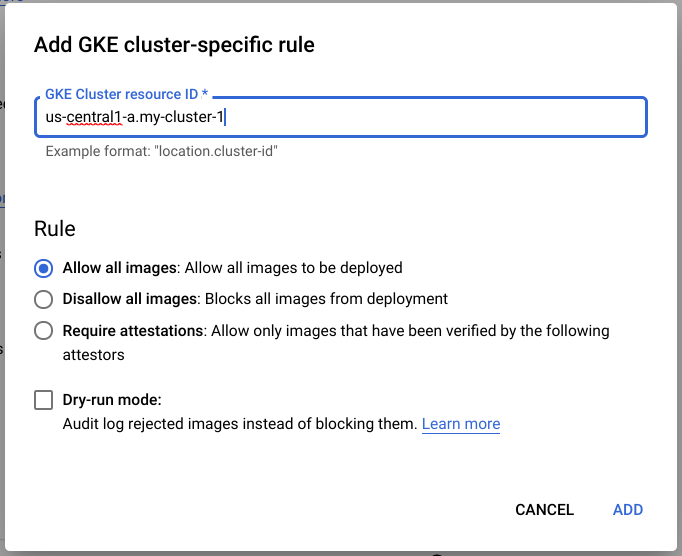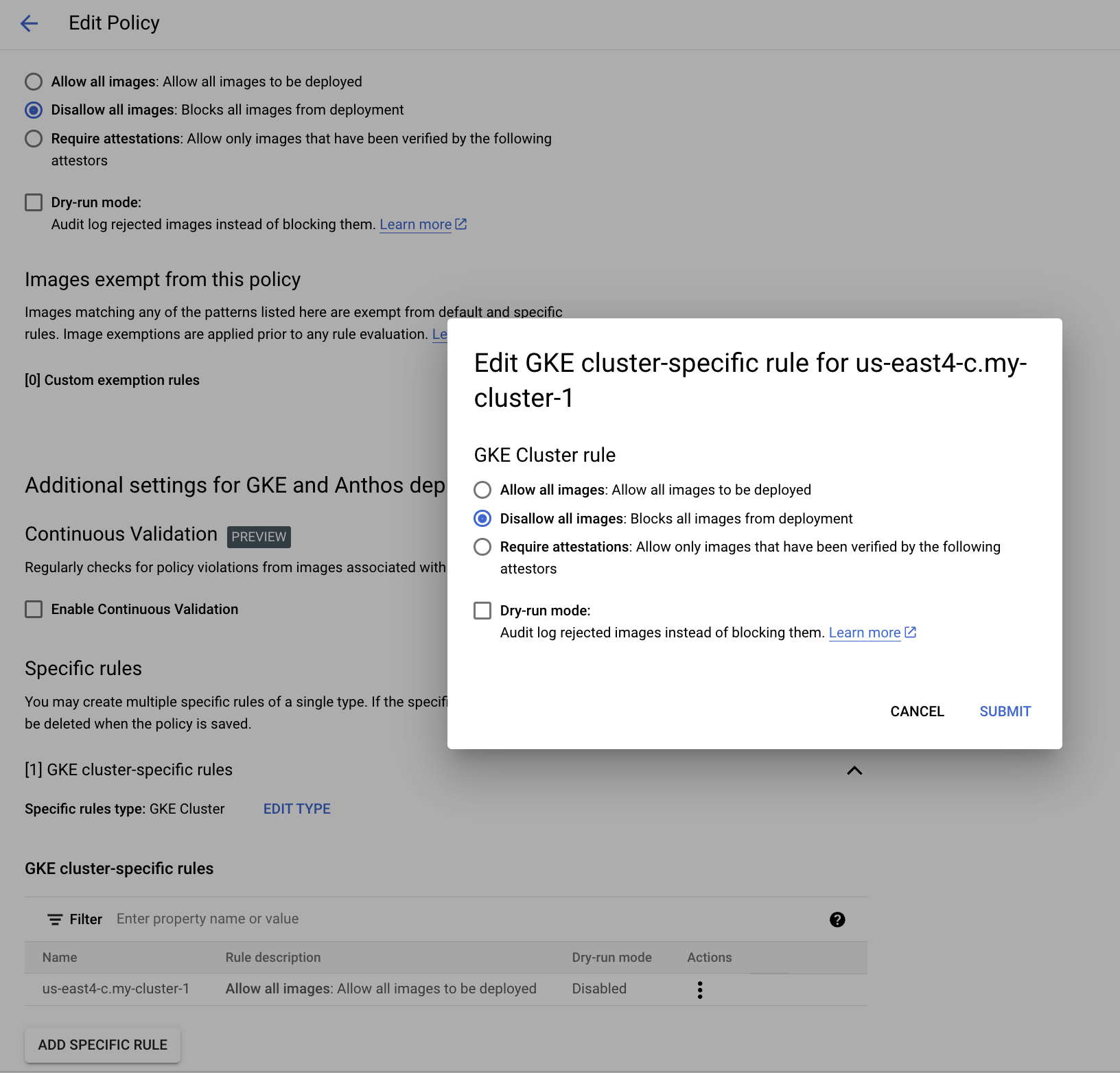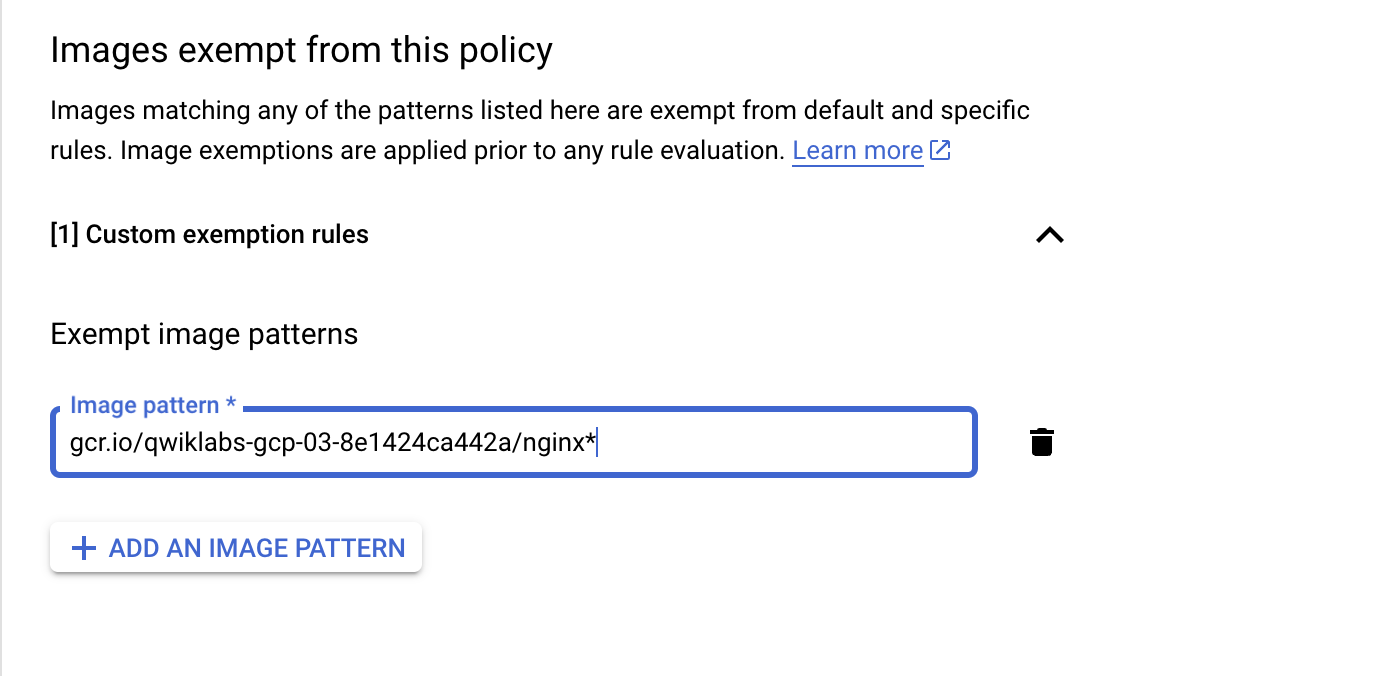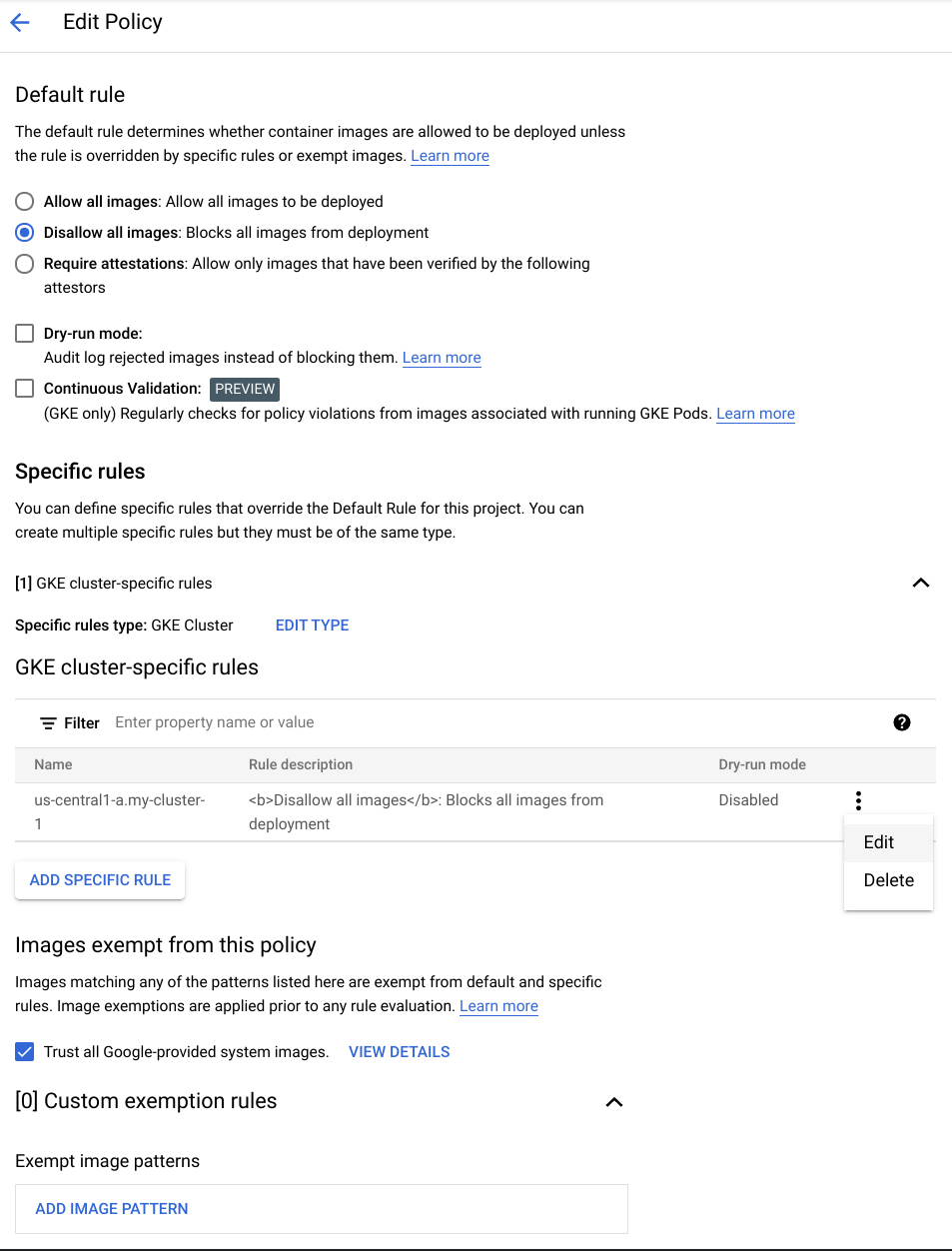Checkpoints
Create a Kubernetes Cluster with Binary Authorization
/ 20
Update Binary Authorization Policy to add Disallow all images rule at project level and allow at cluster level
/ 10
Update cluster specific policy to Disallow all images
/ 10
Create a Nginx pod to verify cluster admission rule is applied for disallow all images (denies to create)
/ 10
Update BA policy to denying images except from whitelisted container registries (your project container registry)
/ 10
Update BA policy to modify cluster specific rule to allow only images that have been approved by attestors
/ 20
Tear Down (delete cluster)
/ 20
Google Kubernetes Engine Security: Binary Authorization
- GSP479
- Overview
- Architecture
- Setup and requirements
- Task 1. Copy resources
- Task 2. Set default cluster version
- Task 3. Deployment steps
- Task 4. Validation
- Task 5. Using Binary Authorization
- Task 6. Creating a private GCR image
- Task 7. Denying all images
- Task 8. Denying images except from allowlisted container registries
- Task 9. Enforcing attestations
- Task 10. "Signing" a container image
- Task 11. Running an image with attestation enforcement enabled
- Task 12. Handling emergency situations
- Task 13. Tear down
- Troubleshooting in your own environment
- Relevant materials
- Congratulations!
GSP479
Overview
One of the key security concerns for running Kubernetes clusters is knowing what container images are running inside each pod and being able to account for their origin. Establishing "container provenance" means having the ability to trace the source of a container to a trusted point of origin and ensuring your organization follows the desired processes during artifact (container) creation.
Some of the key concerns are:
- Safe Origin - How do you ensure that all container images running in the cluster come from an approved source?
- Consistency and Validation - How do you ensure that all desired validation steps were completed successfully for every container build and every deployment?
- Integrity - How do you ensure that containers were not modified before running after their provenance was proven?
From a security standpoint, not enforcing where images originate from presents several risks:
- A malicious actor that has compromised a container may be able to obtain sufficient cluster privileges to launch other containers from an unknown source without enforcement.
- An authorized user with the permissions to create pods may be able to accidentally or maliciously run an undesired container directly inside a cluster.
- An authorized user may accidentally or maliciously overwrite a docker image tag with a functional container that has undesired code silently added to it, and Kubernetes will pull and deploy that container as a part of a deployment automatically.
To help system operators address these concerns, Google Cloud offers a capability called Binary Authorization. Binary Authorization is a Google Cloud managed service that works closely with GKE to enforce deploy-time security controls to ensure that only trusted container images are deployed. With Binary Authorization you can allowlist container registries, require images to be signed by trusted authorities, and centrally enforce those policies. By enforcing this policy, you can gain tighter control over your container environment by ensuring only approved and/or verified images are integrated into the build-and-release process.
This lab deploys a Kubernetes Engine Cluster with the Binary Authorization feature enabled demonstrates how to allowlist approved container registries, and walks you through the process of creating and running a signed container.
This lab was created by GKE Helmsman engineers to give you a better understanding of GKE Binary Authorization. We encourage any one to contribute to our assets!
Architecture
The Binary Authorization and Container Analysis APIs are based upon the open-source projects Grafeas and Kritis.
- Grafeas defines an API spec for managing metadata about software resources, such as container images, Virtual Machine (VM) images, JAR files, and scripts. You can use Grafeas to define and aggregate information about your project’s components.
- Kritis defines an API for ensuring a deployment is prevented unless the artifact (container image) is conformant to central policy and optionally has the necessary attestations present.
In a simplified container deployment pipeline such as this:
The container goes through at least 4 steps:
- The source code for creating the container is stored in source control.
- Upon committing a change to source control, the container is built and tested.
- If the build and test steps are completed, the container image artifact is then placed in a central container registry, ready for deployment.
- When a deployment of that container version is submitted to the Kubernetes API, the container runtime will pull that container image from the container registry and run it as a pod.
In a container build pipeline, there are opportunities to inject additional processes to signify or "attest" that each step was completed successfully. Examples include running unit tests, source control analysis checks, licensing verification, vulnerability analysis, and more. Each step could be given the power or "attestation authority" to sign for that step being completed. An "attestation authority" is a human or system with the correct PGP key and the ability to register that "attestation" with the Container Analysis API.
By using separate PGP keys for each step, each attestation step could be performed by different humans, systems, or build steps in the pipeline (a). Each PGP key is associated with an "attestation note" which is stored in the Container Analysis API. When a build step "signs" an image, a snippet of JSON metadata about that image is signed via PGP and that signed snippet is submitted to the API as a "note occurrence".
(b).Once the container image has been built and the necessary attestations have been stored centrally, they are available for being queried as a part of a policy decision process. In this case, a Kubernetes Admission Controller, upon receiving an API request to create or update a Pod:
- Send a WebHook to the Binary Authorization API for a policy decision.
- The Binary Authorization policy is then consulted.
- If necessary, the Container Analysis API is also queried for the necessary attestation occurrences.
- If the container image conforms to the policy, it is allowed to run.
- If the container image fails to meet the policy, an error is presented to the API client with a message describing why it was prevented.
Setup and requirements
Before you click the Start Lab button
Read these instructions. Labs are timed and you cannot pause them. The timer, which starts when you click Start Lab, shows how long Google Cloud resources will be made available to you.
This hands-on lab lets you do the lab activities yourself in a real cloud environment, not in a simulation or demo environment. It does so by giving you new, temporary credentials that you use to sign in and access Google Cloud for the duration of the lab.
To complete this lab, you need:
- Access to a standard internet browser (Chrome browser recommended).
- Time to complete the lab---remember, once you start, you cannot pause a lab.
How to start your lab and sign in to the Google Cloud console
-
Click the Start Lab button. If you need to pay for the lab, a pop-up opens for you to select your payment method. On the left is the Lab Details panel with the following:
- The Open Google Cloud console button
- Time remaining
- The temporary credentials that you must use for this lab
- Other information, if needed, to step through this lab
-
Click Open Google Cloud console (or right-click and select Open Link in Incognito Window if you are running the Chrome browser).
The lab spins up resources, and then opens another tab that shows the Sign in page.
Tip: Arrange the tabs in separate windows, side-by-side.
Note: If you see the Choose an account dialog, click Use Another Account. -
If necessary, copy the Username below and paste it into the Sign in dialog.
{{{user_0.username | "Username"}}} You can also find the Username in the Lab Details panel.
-
Click Next.
-
Copy the Password below and paste it into the Welcome dialog.
{{{user_0.password | "Password"}}} You can also find the Password in the Lab Details panel.
-
Click Next.
Important: You must use the credentials the lab provides you. Do not use your Google Cloud account credentials. Note: Using your own Google Cloud account for this lab may incur extra charges. -
Click through the subsequent pages:
- Accept the terms and conditions.
- Do not add recovery options or two-factor authentication (because this is a temporary account).
- Do not sign up for free trials.
After a few moments, the Google Cloud console opens in this tab.

Activate Cloud Shell
Cloud Shell is a virtual machine that is loaded with development tools. It offers a persistent 5GB home directory and runs on the Google Cloud. Cloud Shell provides command-line access to your Google Cloud resources.
- Click Activate Cloud Shell
at the top of the Google Cloud console.
When you are connected, you are already authenticated, and the project is set to your Project_ID,
gcloud is the command-line tool for Google Cloud. It comes pre-installed on Cloud Shell and supports tab-completion.
- (Optional) You can list the active account name with this command:
- Click Authorize.
Output:
- (Optional) You can list the project ID with this command:
Output:
gcloud, in Google Cloud, refer to the gcloud CLI overview guide.
Task 1. Copy resources
- Now, you will copy the resources needed for this lab by running:
- Go into the directory for this demo:
Set your region and zone
Certain Compute Engine resources live in regions and zones. A region is a specific geographical location where you can run your resources. Each region has one or more zones.
Run the following to set a region and zone for your lab (you can use the region/zone that's best for you):
Updating files permissions
- Now, make some files readable, writable, and executable for resources needed for this lab:
Task 2. Set default cluster version
- Change the
create.sh's GKE_VERSION variable todefaultClusterVersion:
Task 3. Deployment steps
- To deploy the cluster, execute the following command. Feel free to replace the text
my-cluster-1with the name of the cluster that you would like to create.
The create script will output the following message when complete:
The script will:
- Enable the necessary APIs in your project. Specifically,
container,containerregistry,containeranalysis, andbinaryauthorization. - Create a new Kubernetes Engine cluster in your default ZONE, VPC and network.
- Retrieve your cluster credentials to enable
kubectlusage.
It is safe to ignore warnings.
Task 4. Validation
- The following script will validate that the demo is deployed correctly:
If the script fails, it will output:
And / Or
If the script passes, it will output:
Test completed task
Click Check my progress to verify your performed task. If you have successfully created a Kubernetes cluster with Binary Authorization, you will see an assessment score.
Task 5. Using Binary Authorization
Managing the Binary Authorization Policy
To access the Binary Authorization Policy configuration UI, perform the following steps:
- In the Google Cloud console, navigate to the Security > Binary Authorization.
- Click Edit Policy.
gcloud:
gcloud beta container binauthz policy export > policy.yaml
policy.yaml
gcloud beta container binauthz policy import policy.yaml
The policy you are editing is the "default" policy, and it applies to all GKE clusters in the Google Cloud project unless a cluster-specific policy is in place.
The recommendation is to create policies specific to each cluster and achieve successful operation (allowlisting registries as needed), and then set the default project-level policy to "Deny All Images". Any new cluster in this project will then need its own cluster-specific policy.
- After clicking Edit Policy, the following will appear. Click the down arrow next to Custom Exemption Rules to display them:
The default policy rule is to Allow all images. This mimics the behavior as if Binary Authorization wasn't enabled on the cluster.
If the default rule is changed to Disallow all images or Allow only images that have been approved by all of the following attestors, then images that do not match the exempted registry image paths or do not have the required attestations will be blocked, respectively.
Next, you will make some edits to the policy:
-
Change your Default rule to
Disallow all images -
In Additional settings for GKE and Anthos deployments, click Create Specific Rules.
-
Select GKE Cluster from the dropdown and click Change.
-
Under GKE Cluster-specific rules, Click Add Specific Rule.
-
In the Add GKE Cluster-specific rule field, enter your location and cluster name in the form
location.clustername. e.g..my-cluster-1 which corresponds to the zone and the cluster name my-cluster-1. -
Select the default rule of
Allow all imagesfor your cluster. -
Click ADD.
- Click Save Policy.
Test completed task
Click Check my progress to verify your performed task. If you have successfully updated Binary Authorization Policy to add Disallow all images rule at project level and allow all images at cluster level, you will see an assessment score.
Task 6. Creating a private GCR image
-
To simulate a real-world configuration, create a private GCR container image in your project.
-
You will pull down the
nginxcontainer fromgcr.io/google-containers/nginxproject and push it to your own GCR repository without modification. -
In Cloud Shell, pull down the
latestnginxcontainer:
- Authenticate docker to the project:
When prompted, Do you want to continue (Y/n)? Enter Y.
- Set the PROJECT_ID shell variable:
- Tag and push it to the current project's GCR:
- List the "private" nginx image in your own GCR repository:
Task 7. Denying all images
To prove that image denial by policy will eventually work as intended, first verify that the cluster-specific allow rule is in place and allows all containers to run.
- To do this, launch a single
nginxpod:
You should see a message stating that pod/nginx created.
- List the pods:
Output:
If this fails recheck your cluster-specific region and name and try again.
- Now, delete this pod:
- Next, prove that the Binary Authorization policy can block undesired images from running in the cluster.
On the Binary Authorization page, click Edit Policy,
-
Click on the three vertical dots to the right of your GKE Cluster specific rule, and click edit.
-
Then, select
Disallow all images, click Submit.
Your policy should look similar to the following:
- Finally, click Save Policy to apply those changes.
Test completed task
Click Check my progress to verify your performed task. If you have successfully updated Binary Authorization Policy to Disallow all images rule at cluster level, you will see an assessment score.
- Now, run the same command as before to create the static
nginxpod:
This time, though, you should receive a message from the API server indicating that the policy prevented this pod from being successfully run:
To be able to see when any and all images are blocked by the Binary Authorization Policy, navigate to the GKE Audit Logs in Stackdriver and filter on those error messages related to this activity.
- In the Google Cloud console, navigate to the Navigation menu > Logging > Logs Explorer.
- Populate the Query builder box with:
- Click Run Query.
- You should see errors corresponding to the blocking of the
nginxpod from running.
Test completed task
Click Check my progress to verify your performed task. If you have successfully verified cluster admission rule, you will see an assessment score.
Task 8. Denying images except from allowlisted container registries
-
Let's say that you actually want to allow just that nginx container to run. The quickest step to enable this is to allowlist the registry that it comes from.
-
You will use the output of the following command as your image path:
-
Copy the image path output to your buffer.
-
Navigate to the Navigation menu > Security > Binary Authorization.
-
Edit the Binary Authorization Policy, under Custom exemption rules display the image paths, then click Add an Image Pattern.
-
Paste in the image path you copied earlier. The image below shows an example path.
- Click Save Policy, then run:
You should now be able to launch this pod and prove that registry allowlisting is working correctly.
- Run the following to clean up and prepare for the next steps:
Test completed task
Click Check my progress to verify your performed task. If you have successfully updated Binary Authorization policy to allowlist the container registry, you will see an assessment score.
Task 9. Enforcing attestations
Allowlisting container image registries is a great first step in preventing undesired container images from being run inside a cluster, but there is more you can do to ensure the container was built correctly.
You want to cryptographically verify that a given container image was approved for deployment. This is done by an "attestation authority" which states or attests to the fact that a certain step was completed. The attestation authority does this by using a PGP key to sign a snippet of metadata describing the SHA256 hash of a container image and submitting it to a central metadata repository--the Container Analysis API.
Later, when the Admission Controller goes to validate if a container image is allowed to run by consulting a Binary Authorization policy that requires attestations to be present on an image, it will check to see if the Container Analysis API holds the signed snippet(s) of metadata saying which steps were completed. With that information, the Admission Controller will know whether to allow or deny that pod from running.
Next, perform a manual attestation of a container image. You will take on the role of a human attestation authority and will perform all the steps to sign a container image, create a policy to require that attestation to be present on images running inside your cluster, and then successfully run that image in a pod.
Setting up the necessary variables
- Attestor name/email details:
- Container Analysis Note ID/description of your attestation authority:
- Names for files to create payloads/requests:
Creating an attestation note
The first step is to register the attestation authority as a Container Analysis note with the Container Analysis API. To do this, you'll create an ATTESTATION note and submit it to the API.
- Create the
ATTESTATIONnote payload:
- Submit the
ATTESTATIONnote to the Container Analysis API:
You should see the output from the prior command display the created note, but the following command will also list the created note:
Creating a PGP signing key
As your attestation authority uses a PGP key to perform the cryptographic signing of the image metadata, create a new PGP key and export the public PGP key.
- Set another shell variable:
- Create the PGP key:
-
Press Enter to use an empty passphrase and acknowledge warnings.
-
Extract the public PGP key:
Registering the Attestor in the Binary Authorization API
The next step is to create the "attestor" in the Binary Authorization API and add the public PGP key to it.
- Create the Attestor in the Binary Authorization API:
- Add the PGP Key to the Attestor:
- List the newly created Attestor:
The output should look similar to the following:
Task 10. "Signing" a container image
The preceeding steps only need to be performed once. From this point on, this step is the only step that needs repeating for every new container image.
The nginx image at gcr.io/google-containers/nginx:latest is already built and available for use. Perform the manual attestations on it as if it were your own image built by your own processes and save the step of having to build it.
- Set a few shell variables:
- Get the PGP fingerprint:
- Obtain the SHA256 Digest of the container image:
- Create a JSON-formatted signature payload:
- View the generated signature payload:
- "Sign" the payload with the PGP key:
- View the generated signature (PGP message):
- Create the attestation:
- View the newly created attestation:
Task 11. Running an image with attestation enforcement enabled
The next step is to change the Binary Authorization policy to enforce that attestation is to be present on all images that do not match the allowlist pattern(s).
- To change the policy to require attestation, run the following and then copy the full path/name of the attestation authority:
- Next, edit the Binary Authorization policy to
editthe GKE Cluster specific rule.
Click the three dots by your cluster name to Edit your cluster-specific rules.
- Select
Require attestations (Allow only images that have been verified by all of the following attestors)instead ofDisallow all imagesin the pop-up window.:
- Next, click on
Add Attestorsfollowed byAdd by attestor resource ID. Enter the contents of your copy/paste buffer in the format ofprojects/${PROJECT_ID}/attestors/${ATTESTOR}, then click Add 1 Attestor, and then click Submit, and finally click Save Policy.
The default policy should still show Disallow all images, but the cluster-specific rule should be requiring attestation.
- Now, obtain the most recent SHA256 Digest of the signed image from the previous steps:
- After waiting at least 30 seconds from the time the Binary Authorization policy was updated, run the pod and verify success:
Congratulations! You have now manually attested to a container image and enforced a policy for that image inside your GKE cluster.
Test completed task
Click Check my progress to verify your performed task. If you have successfully updated Binary Authorization policy to modify cluster specific rule to allow only images that have been approved by attestors, you will see an assessment score.
Task 12. Handling emergency situations
From a user's perspective, the Binary Authorization policy may incorrectly block an image or there may be another issue with the successful operation of the admission controller webhook.
In this "emergency" case, there is a "break glass" capability that leverages a specific annotation to signal to the admission controller to run the pod and skip policy enforcement.
In this case, though, your response procedures can be started within seconds of the activity occurring. The logs are available in Stackdriver:
- To run an unsigned
nginxcontainer with the "break glass" annotation, run:
-
In the Google Cloud console, navigate to the Navigation menu > Logging > Logs Explorer page.
-
Populate the Query builder box with below and then Click Run Query:
resource.type="k8s_cluster" protoPayload.request.metadata.annotations."alpha.image-policy.k8s.io/break-glass"="true" -
You should see events when the admission controller allowed a pod due to the annotation being present. From this filter, you can create a
Sinkwhich sends logs that match this filter to an external destination.
Task 13. Tear down
Qwiklabs will remove all resources you created for this lab, but it's good to know how to clean up your own environment.
- The following script will destroy the Kubernetes Engine cluster:
If you created your own cluster name at the beginning of the lab, use that name. In this example the name my-cluster-1 was used.
The last lines of the output will be:
gcloud container clusters list command to track the progress if desired. Wait until cluster get removed.
Test completed task
Click Check my progress to verify your performed task. If you have successfully deleted your cluster, you will see an assessment score.
The following commands will remove the remaining resources.
- Delete the container image that was pushed to GCR:
-
If prompted,
Do you want to continue (Y/n)?enterY. -
Delete the Attestor:
- Delete the Container Analysis note:
Troubleshooting in your own environment
- If you update the Binary Authorization policy and very quickly attempt to launch a new pod/container, the policy might not have time to take effect. You may need to wait 30 seconds or more for the policy change to become active. To retry, delete your pod using
kubectl delete <podname>and resubmit the pod creation command. - Run
gcloud container clusters listcommand to check the cluster status. - If you enable additional features like
--enable-network-policy,--accelerator,--enable-tpu, or--enable-metadata-concealment, you may need to add additional registries to your Binary Authorization policy allowlist for those pods to be able to run. Usekubectl describe pod <podname>to find the registry path from the image specification and add it to the allowlist in the form ofgcr.io/example-registry/*and save the policy. - If you get errors about quotas, please increase your quota in the project. Learn more about resource quotas from the Resource quotas documentation.
Relevant materials
- Google Cloud Quotas
- Signup for Google Cloud
- Google Cloud Shell
- Binary Authorization in GKE
- Container Analysis notes
- Kubernetes Admission Controller
- Launch Stages
Congratulations!
Manual Last Updated April 4, 2024
Lab Last Tested April 4, 2024
Copyright 2024 Google LLC. This software is provided as-is, without warranty or representation for any use or purpose. Your use of it is subject to your agreement with Google.
